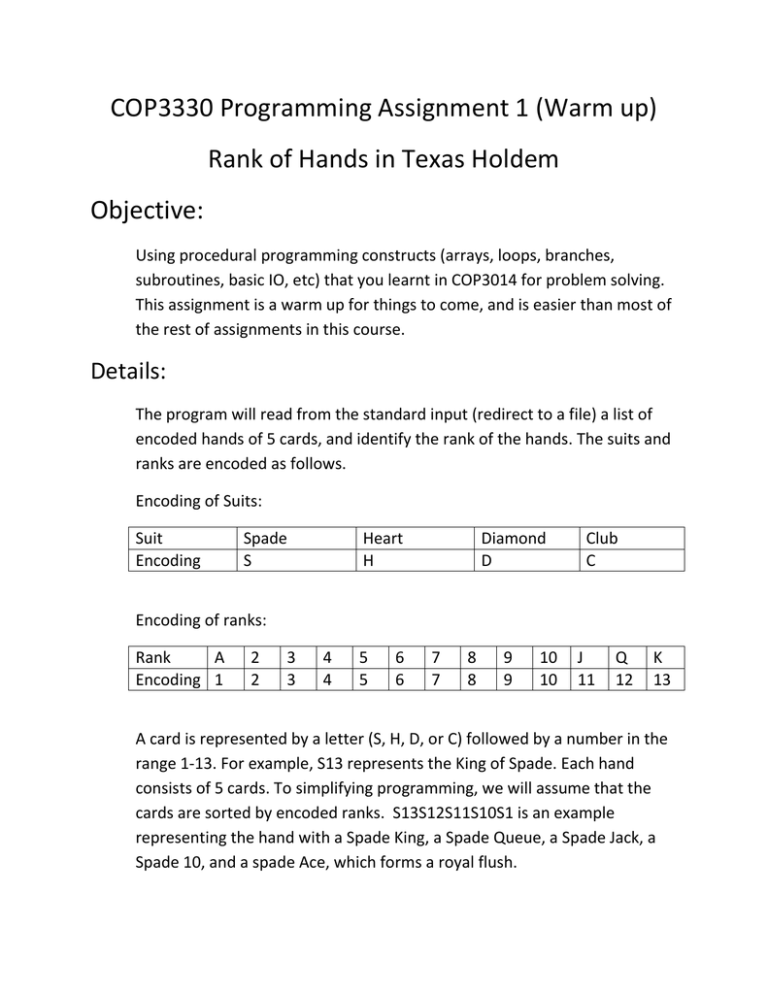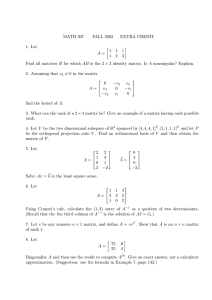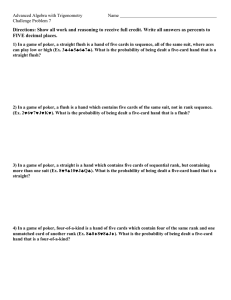COP3330 Programming Assignment 1 (Warm up) Objective:
advertisement

COP3330 Programming Assignment 1 (Warm up)
Rank of Hands in Texas Holdem
Objective:
Using procedural programming constructs (arrays, loops, branches,
subroutines, basic IO, etc) that you learnt in COP3014 for problem solving.
This assignment is a warm up for things to come, and is easier than most of
the rest of assignments in this course.
Details:
The program will read from the standard input (redirect to a file) a list of
encoded hands of 5 cards, and identify the rank of the hands. The suits and
ranks are encoded as follows.
Encoding of Suits:
Suit
Encoding
Spade
S
Heart
H
Diamond
D
Club
C
Encoding of ranks:
Rank
A
Encoding 1
2
2
3
3
4
4
5
5
6
6
7
7
8
8
9
9
10
10
J
11
Q
12
K
13
A card is represented by a letter (S, H, D, or C) followed by a number in the
range 1-13. For example, S13 represents the King of Spade. Each hand
consists of 5 cards. To simplifying programming, we will assume that the
cards are sorted by encoded ranks. S13S12S11S10S1 is an example
representing the hand with a Spade King, a Spade Queue, a Spade Jack, a
Spade 10, and a spade Ace, which forms a royal flush.
The following list is from the best to worst rank of hands in Texas Holdem.
The program would need to recognize all of the ranks.
Royal Flush: An Ace-high straight of one suit. Example: S13S12S11S10S1
Straight Flush: A straight of entirely one suit. Example: D8D7D6D5D4
Four of a kind: Four cards of the same rank. Example: S11H11D11C11D8
Full house: Three-of-a-kind and a pair. Example: D12S12D11S11C11
Flush: Five cards of the same suit. Example: D10D9D3D2D1
Straight: Five cards of sequential rank (Ace can be high or low). Example:
C12H11S10D9D8
Three of a kind: Three cards of the same rank. Example: C13H13S13D2S1
Two pair: two two cards of the same rank. Example: S12D11C11S2D2
One pair: two cards of the same rank. Example C13S10D6S1D1
High card: None of above. Example: C13D10S7S4D2
Your program should read from the standard input (redirect to a file) a list
of encoded hands of 5 cards (one hand on each line), identify the rank of
the hands, print the name of the rank for each hand and the cards in the
hand. The output for a given input file should be identical to that of the
sample executable provided.
The following is a sample input (in file testcase0.txt):
S13S12S11S10S1
D5D4D3D2D1
C8C7C6C5C4
S11D11C11H11D8
S13J13S12D12H12
C13C4C10C2C5
C12H11S10D9D8
S5D4D3S2D1
C13H13S13D2S1
S12D11C11D2H2
C13S10D6S1D1
C13D10S7S4S2
The corresponding output of the program should be (see the execution of
proj1_linprog):
Loyal flush: S13S12S11S10S1
Straight flush: D5D4D3D2D1
Straight flush: C8C7C6C5C4
Four-of-a-kind: S11D11C11H11D8
Full house: S13J13S12D12H12
Flush: C13C4C10C2C5
Straight: C12H11S10D9D8
Straight: S5D4D3S2D1
Three-of-a-kind: C13H13S13D2S1
Two pair: S12D11C11D2H2
One pair: C13S10D6S1D1
High card: C13D10S7S4S2
Submission
The due time for this assignment is May 22 (Wendesday), 2013. 11:59pm.
Name your program as proj1.cpp (and proj1.h if you have a header file). Tar
all of your files for this assignment (which should include at least two files
proj1.cpp and bug_fixing_log.txt, your bug fixing log file), name the tar file
yourlastname_firstinitial_proj1.tar and submit the tar file in blackboard.
The bug fixing log file must follow the template given in the class website.
Grading policy:
The program must work on linprog. O point for programs with any g++
compiler error on linprog. You will need to track compiling errors that you
fixed by yourselves in a log for fixed compiler bugs that needs to have at
least two entries for 5 points/each entry (10 points max).
Program with no compiler error (20 points)
Log for fixed compiler bugs (10 points)
Program able to display the input cards (20 points)
Program able to identify all loyal flush correctly (6 points)
Program is able to identify all straight flushes correctly (12 points)
Program able to identify all of the rest ranks (4 points each rank, 32
points total)
Hints:
1. Start the project as soon as possible.
2. You can store each hand in two arrays, a character array for the suit and
a character array for the rank.
3. You should write one routine for checking one rank (you will need to
write ten such routines). Routine for checking whether the hand is a
loyalflush can be as follows. Other routines are similar.
int isloyalflush(char suit[5], int rank[5]) {
if (suit[0] != suit[1]) return 0;
if (suit[0] != suit[2]) return 0;
if (suit[0] != suit[3]) return 0;
if (suit[0] != suit[4]) return 0;
if (rank[0] != 13) return 0;
if (rank[1] != 12) return 0;
if (rank[2] != 11) return 0;
if (rank[3] != 10) return 0;
if (rank[4] != 1) return 0;
return 1;
}
4. The main program structure would be as follows:
While (there are more inputs) {
Read one line of hand into the suit and rank arrays
If (isloyalflush(…)) output ‘loyal flush: ‘;
else if (isstraightflush(…)) output ‘straight flush: ‘;
else if ….
…
Output the hand read
}




